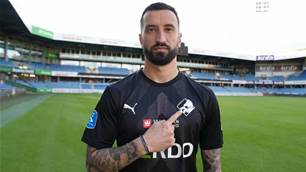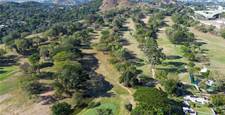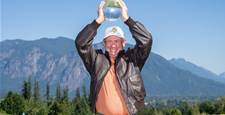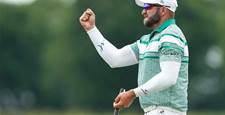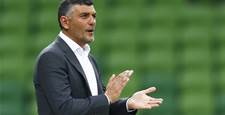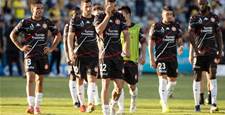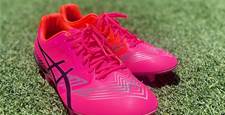DIZZY highs, miserable lows and landmark changes. Here are our top 50 moments, in no particular order, that shaped and defined Australian football as we know it today
Joe Marston is first Aussie in FA Cup Final 1954
Uncompromising defender Joe Marston plied his trade in the English top flight long before the EPL hosted its current cocktail of foreign stars.
When Marston lined up for Preston in the 1954 FA Cup final against West Brom, he was the only non-British player on his side. The opposite side boasted only one non-English player, an Irishman by the name of Reg Ryan. The idea of a player from 10,000 miles away playing the world's oldest cup tournament was an alien concept in the '50s English game.
West Brom got the better of Marston's side that day running out 3-2 winners, but the following year Marston was appointed Preston captain and he went on to become one of only two Australian footballers to receive an MBE from the Queen, with the other recipient being Johnny Warren.
We've become accustomed to watching the likes of Cahill, Neill and Schwarzer find a home in the English league, but Marston was the original Aussie export to the English game.
And popular one at that - in 2000 Joe was chosen in Preston's Best 100 Players Of All Time (trust us when we say that's more impressive than it sounds today!)
Adelaide show Asia that Aussie clubs can play
The Asian game has often been seen as the yardstick for development in Australia.
Since joining the AFC, our Socceroos first failed in the Asian Cup, before redeemed themselves with a comprehensive World Cup qualification campaign by topping their group.
Expectations at a club level were more modest. Just having Asian Champions League qualification places on offer through the A-League seemed reward enough, so when Adelaide took the competition by storm last year it showed the whole of Asia we were not there to make up the numbers.
After topping their group without losing a game, the Reds surpassed J. League outfit Kashima Antlers in the quarters, before toppling Uzbek side Bunyodkor, with World Cup winner Rivaldo, in the semis.
Gamba Osaka may have ended Adelaide's run in emphatic style by beating them 5-0 in the final, but the A-League side had done enough to reach the Club World Cup, where they again battled valiantly.
For once it wasn't just the Socceroos fighting the Australian cause overseas, Australian club football had something to say too.
Kewell makes Aussie debut against Chile
Harry Kewell made his Socceroos debut in a friendly against Chile in April 1996, aged 17 years and seven months. The significance of his first appearance is not linked to his performance on the day as such, but rather what it cemented for years to come.
His debut was a safeguard to ensure a more established football nation didn't persuade Harry to shift allegiance.
"You never know, otherwise those sneaky Poms could have had Harry playing for England," Kewell's manager Bernie Mandic told FourFourTwo earlier in the year. "Even after Harry had played for Australia, there was still pressure for him to wait four years and then play for England."
It sends a shudder down the spine of every Socceroo fan to image Harry lining-up in the white of England. Thankfully a premature debut for a teenage phenom ensured that wasn't the case.
Making 1992 Olympics semis in Barcelona
The year 1992 was the first time we referred to our U23s as 'The Olyroos'. And these boys - mostly from the NSL - set a standard yet to be matched. They were simply sensational in qualifying and in Barcelona.
Reaching the 1992 Olympics, they famously knocked out Holland in the final qualifier. Coached by the late Eddie Thomson, the Aussies snatched a 1-1 draw at the SFS and headed to Utrecht for the second leg, where they were expected to fall short against the Dutch.
Elegant Olyroo libero Ned Zelic's extraordinary extra-time goal - his second of the game - capped a remarkable 2-2 draw with Australia advancing through on the away-goals rule.
Proving this was no fluke at all, Australia made the semis of the Barcelona Olympics. A loss to Nii Lamptey's Ghana 3-1 in Sabadell was followed by a 1-1 draw with Mexico in Barcelona.
The Aussies then found a new level with a 3-0 defeat of Denmark. Goals to Tony Vidmar, John Markovski and Damian Mori handing them a quarter-final date with Sweden, where the Olyroos held on for a 2-1 win against Thomas Brolin's side.
This set up a semi with Poland, but a 6-1 thumping finally brought the green and gold down to earth in some style. This was followed by a 1-0 loss to Ghana in the bronze medal play-off.
A disappointing end, yes, but the careers of Zelic, Paul Okon, John Filan, Milan Blagojevic, Tony Vidmar and others were assured after this fabulous run.
TV deal signed with Fox Sports 2005
"A transforming transaction for the sport," was Frank Lowy's assessment of Fox Sports inking their $120m, seven year TV rights deal in 2005.
If money makes the world go round, then Fox Sports considerable fiscal contribution got the Australian game in motion and helped transform the game on every level.
It was not just about money - the wide-reaching coverage of the A-League, Asian Cup, Asian Champions League and all Socceroos fixtures got the local game into homes and pubs across the country.
Football captured a broader community and speaking generally Fox also did a stellar job of putting together a professional and entertaining product.
While some people today bemoan the restricted access to the game, Fox Sports deserve to be in that position. Fox put their money where their mouth is from the start and have earned the right to dominate the coverage stakes.
"Was it a transforming transaction for the sports?" said ex-FFA CEO John O'Neill to FourFourTwo back in 2007. "Yes, it was. Absolutely no question."
Sydney catches a dose of Beckham fever
The biggest selling point football has is that it is truly a global game. A language understood across the world. As such, its stars can be exported anywhere and no player garners such universal attention as David Beckham.
When Becks came out to Australia in November 2007, locals found themselves going as giddy with excitement at the prospect of 'Golden Balls' mooching around Homebush in a showcase friendly with an A-League side in Sydney FC.
Far from mooch, Becks - and Sydney FC themselves - didn't disappoint the 80,000 fans in a eight-goal thriller. The spectacle of Sydney's goals and LA Galaxy's woeful goalkeeper Steve Cronin was more than matched by the man we were all there to see.
As half-time approached Sydney were cantering 3-0, but as Galaxy won a free-kick on the edge of the box anticipation grew from a crowd aware of what could follow next. Beckham produced a trademark free-kick finish and the crowd celebrated in a similar fashion to the previous three goals.
The purists will disagree, but while Australia still fights to shift general public opinion of the beautiful game, this game produced all the goals and glamour needed to convert the armchair fans into dedicated followers. Channel 10 showing the game was another coup for the showpiece.
This showed us the Beckham brand was universal and so is the game of football.
Harry Williams leads way for Aboriginals
Through the FFA's recently launched Indigenous Football Development Program, the need to harness and bolster Aboriginal football ties has taken centre stage.
Back in the days before such programs, Harry Williams became a pioneer by starring as the first Aboriginal Socceroo. A quiet and shy man off the field, Williams, who grew up in Sydney's St George area, went on to earn 44 caps and played briefly at the 1974 World Cup.
Though the number of Aboriginal Socceroos after him is a disappointment, Williams remains an iconic figure for breaking the mould. That said, the man himself always claimed his background had little relevance to his role in the Socceroos.
"We were all soccer players and it didn't matter where we were from," says Williams. "No one went about congratulating me because I was an Aboriginal playing soccer."
Williams was called upon to speak in Canberra during the recent World Cup bid launch and lends his name to a tournament aimed at bringing together indigenous footballers in Sydney.
Australia joins the Asian Confederation
The flurry of changes under the new Frank Lowy-driven Football Federation Australia included a long touted entry into the Asian football confederation in 2005.
If Australia was ever to bloom as a football nation, it needed to break the shackles of the OceaniaConfederation and its many Pacific island minnows.
How could the game in Australia ever be taken seriously with results like the 33-0 victory over American Samoa? The result was a joke, and so Australian football got tarred with the same laughable brush.
The move into Asian seemed a natural one for the freshly funded Australian football landscape. For the Socceroos, rather than the rudimentary Oceania walkovers followed by a do-or-die playoff against a South American nation, they were to be pitted against a host of technically-sound Asian nations over an extended period of time.
Qualification through Asian became a long slog, but one which drew the squad together and ensured we entered into next year's World Cup in the sharpest shape ever.
Domestically, the A-League was no longer a floating domestic afterthought. There was the Asian Champions League to aim for and as Adelaide showed last year, the possibility to excel in the tournament and make the Club World Cup.
We now find ourselves part of something bigger and better, and we're the better for it.
Tim scores our first World Cup goal in first ever finals victory
Qualification to the 1974 World Cup was achieved in the face of adversity, while a goalless and winless performance at the finals was entirely expected.
Bounding into the 2006 edition as the last team to qualify bought its own challenges, especially when the draw threw out Japan, Croatia and the mighty Brazilians.
Each time the Socceroos reach another milestone, they are also raising the bar of expectations for the future. Tim Cahill did more for those expectations in a few minutes against Japan than any other Aussie has done before or since.
With just six minutes remaining in the opening fixture for the Aussie at the 2006 World Cup, Japan were winning 1-0 and set to put the brakes on the dawn of a new era for Australian football before it had even begun.
Then our nation was shown the drama of footballing theatre at its best. Super sub Cahill turned the game - and our World Cup fortunes - on their head with two stunning strikes to turn a 0-1 deficit to a 2-1 lead. John Aloisi put the icing on the cake with a well-taken third.
To enter the World Cup stage in such a dramatic fashion was exhilarating for players and fans alike. It was breathtaking stuff and kick-started a successful month of football.
The feeling in the aftermath of the game is stored by all Socceroo players and fans alike. Getting that feeling back is what has driven us all onto South Africa. Can we recreate that feeling? Time till tell but one thing's for sure -we certainly won't forget it.
The A-league kicks off
In the wake of the Crawford Report and the death of Soccer Australia, the country needed a fresh identity for its new-found football landscape.
The NSL was ravaged by an exodus of talent moving overseas, a botched TV deal with Seven, a drop in sponsorship interest and ethnic tensions which defined club rivalries everywhere.
Australians needed local sides which represented their areas' identity and this fresh approach was realised in 2005 when the Hyundai A-League was born.
Well organised, funded and promoted, the league was an outlet for the whole community. It was the shiny new tournament needed to bring local fans to the grounds, and returning stars, rising young talent and exciting imports on the pitch.
While the league is still finding its feet today, the FFA have insisted the competition is a long-term venture. There is still work to be done, but sometimes it is worth casting your mind back to pre-A-League days to fully appreciate what we have today.
Continued on next page
Related Articles

Socceroos midfielder embraces move to England
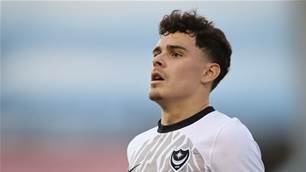
Cardiff City snap up sought-after Socceroos starlet
